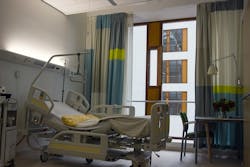Hospital floors are hotspots for bacteria
The floors of hospital rooms are quickly and frequently contaminated with antibiotic-resistant bacteria within hours of patient admission, creating a route of transfer of potentially dangerous organisms to patients, according to a study published today as part of the proceedings from Decennial 2020: The Sixth International Conference on Healthcare-Associated Infections.
Decennial 2020, an initiative of the Centers for Disease Control and Prevention (CDC) and the Society for Healthcare Epidemiology of America (SHEA), was cancelled in March due to the pandemic. All abstracts accepted for the meeting have been published as a supplement issue in the journal Infection Control & Hospital Epidemiology, according to a news release from SHEA.
Researchers with the Northeast Ohio VA Healthcare System closely tracked contamination in hospital rooms of 17 newly admitted patients to identify the timing and route of transfer of bacteria within patients’ rooms. Before testing, rooms were thoroughly cleaned and sanitized and all patients screened negative for methicillin-resistant Staphylococcus aureus (MRSA) and other healthcare-associated bacteria. Researchers then observed patients’ interactions with healthcare personnel and portable equipment, collecting cultures one-to-three times per day from patients, their socks, beds and other high-touch surfaces, as well as key sections of the floor.
Nearly half of rooms tested positive for MRSA within the first 24 hours, and MRSA, C. difficile, and vancomycin-resistant enterococci (VRE) pathogens were identified in 58 percent of patient rooms within four days of admission. Contamination often started on the floors, but ultimately moved to patients’ socks, bedding, and nearby surfaces.
In a related study published in August in Infection Control & Hospital Epidemiology, the authors reported similar findings of frequent detection of SARS-CoV-2 nucleic acid on floors and on shoes of personnel on a COVID-19 ward. The authors note that further research is needed to clarify the role of floor contamination in transmission of both bacterial and viral pathogens and to identify practical approaches to address contamination. On the COVID-19 ward, contamination was reduced with simple modifications of floor cleaning and disinfection protocols.
